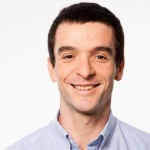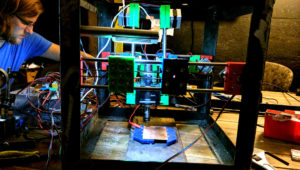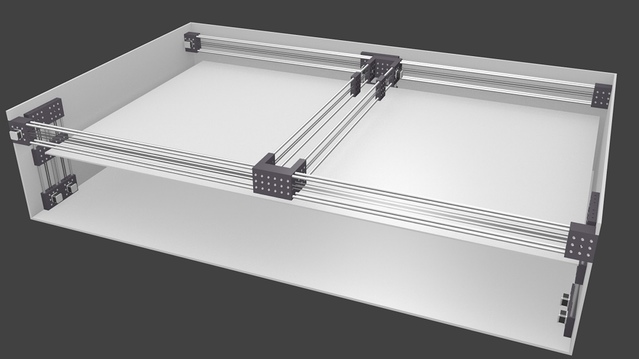Build Yourself. Build Your World.
Join a workshop with Marcin Jakubowski (Global Village Construction Set) where you will build and calibrate your own 3D Printer in one day, while also learning how to generate 3D printing files in FreeCAD.
You will be able to take your 3D printer home with you in one of two sizes: large 12″x12″ square print bed, or small 8″x8″ print bed.

Specifications:
- High Performance Components
- Steel frame (robust for 3D printing and other applications)
- Print bed: 8″x8″ or 12″x12″
- PEI heated build surface (state-of-the-art for easy part removal, parts almost pop off the surface once a print cools)
- Titan Aero extruder with Volano nozzle* (one of the most advanced, flexible, and designed for both standard filaments and rubber)
- LCD display with SD card reader (use the 3D printer standalone without tying up your computer)
- Universal Axis (universal motion system)
- Quick Connect toolhead mount** (interchangeable and magnetically mounted)
* The extruder can use both small nozzles and large nozzles (1.2mm size) for 10x faster printing.
** Quick Connect allows the use of other toolheads (note: not included in this workshop, e.g. a laser cutter or CNC circuit mill head) in the same motion system.

2 for 1 offer: bring a friend with you for free to assist with your build.

- Marcin Jakubowski – Marcin was trained as a fusion physicist. He left academia right after finishing his Ph.D. to start a farm – in Missouri. For the last 7 years, he has been working on the Global Village Construction Set – a set of enabling tools and machines for building regenerative infrastructures. Marcin is passionate about creating the Open Source Economy – a new operating system for Earth. See Marcin’s bio.
See a video from one of our last year’s workshops at Open Source Ecology for what a build looks like:
Most importantly – from the OSE perspective – the 3D printer is a construction set. It is made of the Universal Axis – and other building blocks – such that the printer could be enlarged or modified as need. In the afternoon session, we will participants how to design a 3D printer using the OSE 3D Printer Construction Set – and how to design parts for printing in FreeCAD – so bring your computer if you’d like to participate. We will use the FreeCAD open source CAD software.
The same axis module can be used in the x,y, and z directions – to create the x-y-z motion system:
Using this Universal Axis and taking advantage of the Construction Set approach, we have already built an open source CNC circuit mill. We reconfigured the axes compared to our 3D printer, and added a small router.

The metal guide rods can be larger or smaller – such as 1″ rods for heavier duty applications. The same axes as used above can be joined, lengthened, or stacked to build a much larger machine – such as this 4’x8’x1′ CNC Router:

Note how the basic axis unit and its ability to connect to other axis units allows for a wide range of design variations, putting the ability to design CNC machines within the hands of ordinary people. Depending on the tool head that is used – the machine can have the functionality of the corresponding tool head – whether a 3D printer extruder, a router, a laser cutter, a cutting torch, or many others.

Lowest Unique Part Count in the World
The beauty lies in an absolute minimum number of parts that are used to build an infinite variety of CNC machines – depending on size, axis configuration, and tool heads. The unique part count for our 3D printer is only 40 – about half of comparable printers.
By making our machines simple and universal, we are aiming for the most widely replicated CNC build system in the world. To that end, we are inviting developers and entrepreneurs to join the OSE Development Team.
This workshop builds upon OSE’s Extreme Manufacturing approach of rapid building with multiple teams working in parallel on modular components. By simplifying the design and streamlining the build with digitally-fabricated, open source parts – people are now able to build a high quality 3D printer in record time at low cost.
We are also developing an open source enterprise model for how to run such workshops anywhere in the world. Would you like to work with us doing something extraordinary? We are hiring – so if you are interested in learning how to run workshops like ours – we invite you to see what we are about – and then join us in either a part time or full time capacity. Onboarding here involves participating in one workshop, then assisting in 2 more workshops – and learning up to the point where you feel comfortable running the workshops. This requires people who are both technical – and who can teach. But we actually prefer people who can teach over those who are technical – as learning to teach is probably more difficult than learning the technical aspects.
Open Source Ecology has a much larger vision. See Marcin’s TED Talk:
This year, we are starting an immersion program so that we can accept many new developers – who can work with OSE full time. Hear more about the Immersion Training Program. The Open Source Microfactory Boot Camp is the first week of the OSE 5 Week Immersion Training Program:
The 3D printer is part of a larger narrative:
3D printing and open source micromanufacturing, in its infancy, has great potential for distributing production. We start with a 3D printer, so we can set up an online printing service for producing parts. In order to expand our enterprise – and enable the printing of large objects at low cost – we diversify into producing 3D printing filament from scrap plastic. We grind down scrap plastic, extrude it into 3D printing filament with our filament maker, and then wind it onto spools with the filament winder. Produced at a cost of only 10 cents per lb – we have inexpensive 3D printing filament that is almost free. So we can run an online 3D printing service successfully.
Can we then develop high value products that are competitive with standard consumer goods? That is our goal. So we collaborate on the Open Source Everything Store, where we design a whole catalog of products that compete with Amazon and Walmart – but are designed and produced locally. Household consumer goods total a $20T global market – so the pie is large and there is plenty of room for collaboration. It turns out that with 3D printing, a CNC Circuit Mill, and a small laser cutter/engraver – and a bunch of readily available, off-the-shelf parts – we can produce a whole range of useful products, and thus begin to effect manufacturing in a substantial way.
We are excited, and want to spread the word. So we run public workshops teaching people to build these machines, and how to design products that can be made with these machines – using a completely open source toolchain. We take this to our local libraries, schools, events – and involve thousands of people in collaborative product design. We teach people about massive parallel swarm-based development techniques – and every child and grandmother begin designing their own products and publishing the plans on the internet for free. The depth of local manufacturing increases – and people begin making more of the parts that would normally be purchased – such as motors and power supplies. We democratize the face of manufacturing – converting consumers to producers…
That is the narrative we’d like to see happen, and the 1 week OSE Boot Camp is an introduction to how to do this in practice. We will learn to design and use the open source Level 1 Microfactory, consisting of important desktop manufacturing tools. These tools are: a 3D printer, CNC Circuit Mill, Laser Cutter, and Filament maker. Participants will build a 3D printer to take home with them.
Some may say that this is already happening – but 3D printing and distributed manufacturing has not taken much of a hold in terms of replacing consumer goods. The key is high quality, proven designs – not fringe items on 3D printing websites that in many cases cannot even be printed. The key is engaging enough cooperation – that all the possible products truly become best-in-class – while remaining fully open source. We not only show you that this new mindset is possible – but how to build the actual production tools – and how to leverage massive collaborative development processes – so that we democratize product development on the face of this earth.
Perhaps the greatest single impact is environmental – as people learn to build their products – they also know how to fix them – thereby putting an end to the throw-away society – with lifetime design that can be modified, improved, or recycled back into feed-stocks. Our aim in the OSE Boot Camp is to introduce people to the first steps in seizing democratic control of production.
Have questions? Drop us an email: info at opensourceecology dot org
2 for 1 offer: bring a friend with you for free to assist with your build.
Note: the registration is for the 3D printer build for those who would like to build a 3D printer to take home with them. Otherwise, the Eco-Media Arts Festival event is free.
Welcome message from Marcin:
True Fans of OSE: As supporting members of OSE, True Fans who have been subscribed for 6 or more months receive a 25% discount on all of our workshops. This discount is only for the tuition part part of the registration fee, but not the 3D printer materials cost. Email us for details. You can sign up as a True Fan now to become eligible for the True Fans discount on future workshops.
Sponsor another participant or Donate to OSE: We are a nonprofit organization with 501(c)3 status, and you can make tax-deductible contributions to us. You can fund attendance of someone who is on the waiting list for financial assistance. We receive low-income assistance requests for all of our workshops. Sponsor by paying the quantity on the order form, or use the donate button below. Please email us at info@opensourceecology.org that you are sponsoring someone else. We can send you a tax deduction receipt.
Donate through PayPal:
![]() Donate through BitCoin:
Donate through BitCoin:

Bitcoin Address: ”’166yC48RakrZdtsBj36vY9q29CpzknHbxY”’
Payment Options: eCheck, PayPal, Credit Card, Bitcoin, Check, Money Order, or Wire Transfer
To register, you can use PayPal or eCheck options. We prefer that you use the eCheck option (bank routing + account number) so we can avoid the 3% PayPal fee. We can also accept Bitcoin, checks, and wire transfers.

Comments are closed, but trackbacks and pingbacks are open.